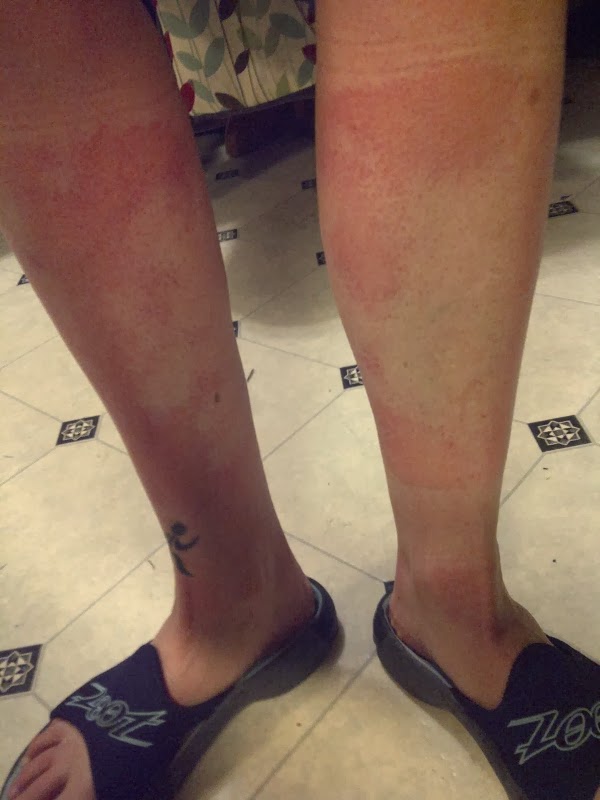I was distinctly less amused when I got out of my now-wet clothes after coming inside and discovered that my lower legs looked like this:
 |
| Son of a diddly! |
Finally, realisation dawned. It was all because of SCIENCE!
As I'd been running, I'd started to sweat a bit. It's a thing that happens. The knicks (and, for that matter, my socks) had done an effective job of transporting the moisture away from my skin and out through the hydrophobic polyester fibres of my fleece pants. When it made contact with the frigid air (which actually turned out to be -21c/-6f, as the weather app on my phone hadn't updated the home screen display when I checked), it then froze up, resulting in the fuzzy-looking ice coating on my leg. This is all well and good, and I'm going to assume it only happens on the side & back of my leg because the wind chill of my own forward motion keeps the front of my quads from sweating as much.
The problem with my lower legs is that the loose fit of the pants meant there was no fabric in direct contact with the skin, which meant no moisture transport. Instead of being wicked away, the sweat just sat on my skin and was chilled by the cold air. In summer, that would be considered "doing its job" - the evaporative cooling effect of sweat on skin is what allows humans to run long distances, and can be seen as a major driving factor in our species' evolution. In winter, though, it can be really dangerous!
 |
| Scumbag water. |
While air itself can act as an insulating layer, it has to be in a closed environment that severely limits the entry of cold air (or rather, loss of heat) and the loose, open bottom cuffs of the fleece pants just couldn't cut it. An elastic band around the bottom of each would have made a huge difference, as the trapped warmth of my body would have prevented the sweat from trying to freeze on my skin. This is a big reason why clothing made for cold conditions generally includes elastic, hook-and-loop or drawstrings at cuffs and hems in order to lock in your body's warmth. Heck, if I'd even tucked the bottom of my pants into the cuffs of my socks I probably wouldn't be writing this, though I may have risked arrest by the fashion police.
You may be thinking to yourself that if I'd been fitter, maybe I wouldn't have sweat as much on that run. Au contraire, mon frère! While everyone's sweat rate will be slightly different, by and large fit people will actually sweat sooner and more copiously than unfit people. It's part of that awesome adaptation that lets us work harder and longer without raising our core temperature past the point at which we'd start to break down.
So, where does this leave me?
The next night I headed out in virtually identical weather: it was -20c/-4f with similar wind, and I dressed identically to the night before with the exception of wearing full-length lightweight merino wool tights under my fleece pants. The results?
 |
While most of us know how much more comfortable it is to run in wicking apparel in the summer heat, we may not always think about the need to move sweat away from our skin when temperatures drop. Please, take this as my warning that you disregard this factor at your peril! If you're still running in cotton or other materials that aren't effective at moisture transport, I highly suggest you look into at least a few pieces of kit that will make your life so much more comfortable, if not actually a great deal safer.
Fortunately, my legs are fine - had returned to their proper colour with no lasting effects after a good swim workout following Tuesday night's run. May I always be so lucky in my adventures as your cautionary example!



No comments:
Post a Comment
Go on, have at me!